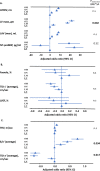Associations of obesity and malnutrition with cardiac remodeling and cardiovascular outcomes in Asian adults: A cohort study
- PMID: 34061848
- PMCID: PMC8205172
- DOI: 10.1371/journal.pmed.1003661
Associations of obesity and malnutrition with cardiac remodeling and cardiovascular outcomes in Asian adults: A cohort study
Erratum in
-
Correction: Associations of obesity and malnutrition with cardiac remodeling and cardiovascular outcomes in Asian adults: A cohort study.PLoS Med. 2021 Sep 13;18(9):e1003784. doi: 10.1371/journal.pmed.1003784. eCollection 2021 Sep. PLoS Med. 2021. PMID: 34516581 Free PMC article.
Abstract
Background: Obesity, a known risk factor for cardiovascular disease and heart failure (HF), is associated with adverse cardiac remodeling in the general population. Little is known about how nutritional status modifies the relationship between obesity and outcomes. We aimed to investigate the association of obesity and nutritional status with clinical characteristics, echocardiographic changes, and clinical outcomes in the general community.
Methods and findings: We examined 5,300 consecutive asymptomatic Asian participants who were prospectively recruited in a cardiovascular health screening program (mean age 49.6 ± 11.4 years, 64.8% male) between June 2009 to December 2012. Clinical and echocardiographic characteristics were described in participants, stratified by combined subgroups of obesity and nutritional status. Obesity was indexed by body mass index (BMI) (low, ≤25 kg/m2 [lean]; high, >25 kg/m2 [obese]) (WHO-recommended Asian cutoffs). Nutritional status was defined primarily by serum albumin (SA) concentration (low, <45 g/L [malnourished]; high, ≥45 g/L [well-nourished]), and secondarily by the prognostic nutritional index (PNI) and Global Leadership Initiative on Malnutrition (GLIM) criteria. Cox proportional hazard models were used to examine a 1-year composite outcome of hospitalization for HF or all-cause mortality while adjusting for age, sex, and other clinical confounders. Our community-based cohort consisted of 2,096 (39.0%) lean-well-nourished (low BMI, high SA), 1,369 (25.8%) obese-well-nourished (high BMI, high SA), 1,154 (21.8%) lean-malnourished (low BMI, low SA), and 681 (12.8%) obese-malnourished (high BMI, low SA) individuals. Obese-malnourished participants were on average older (54.5 ± 11.4 years) and more often women (41%), with a higher mean waist circumference (91.7 ± 8.8 cm), the highest percentage of body fat (32%), and the highest prevalence of hypertension (32%), diabetes (12%), and history of cardiovascular disease (11%), compared to all other subgroups (all p < 0.001). N-terminal pro B-type natriuretic peptide (NT-proBNP) levels were substantially increased in the malnourished (versus well-nourished) groups, to a similar extent in lean (70.7 ± 177.3 versus 36.8 ± 40.4 pg/mL) and obese (73.1 ± 216.8 versus 33.2 ± 40.8 pg/mL) (p < 0.001 in both) participants. The obese-malnourished (high BMI, low SA) group also had greater left ventricular remodeling (left ventricular mass index, 44.2 ± 1.52 versus 33.8 ± 8.28 gm/m2; relative wall thickness 0.39 ± 0.05 versus 0.38 ± 0.06) and worse diastolic function (TDI-e' 7.97 ± 2.16 versus 9.87 ± 2.47 cm/s; E/e' 9.19 ± 3.01 versus 7.36 ± 2.31; left atrial volume index 19.5 ± 7.66 versus 14.9 ± 5.49 mL/m2) compared to the lean-well-nourished (low BMI, high SA) group, as well as all other subgroups (p < 0.001 for all). Over a median 3.6 years (interquartile range 2.5 to 4.8 years) of follow-up, the obese-malnourished group had the highest multivariable-adjusted risk of the composite outcome (hazard ratio [HR] 2.49, 95% CI 1.43 to 4.34, p = 0.001), followed by the lean-malnourished (HR 1.78, 95% CI 1.04 to 3.04, p = 0.034) and obese-well-nourished (HR 1.41, 95% CI 0.77 to 2.58, p = 0.27) groups (with lean-well-nourished group as reference). Results were similar when indexed by other anthropometric indices (waist circumference and body fat) and other measures of nutritional status (PNI and GLIM criteria). Potential selection bias and residual confounding were the main limitations of the study.
Conclusions: In our cohort study among asymptomatic community-based adults in Taiwan, we found that obese individuals with poor nutritional status have the highest comorbidity burden, the most adverse cardiac remodeling, and the least favorable composite outcome.
Conflict of interest statement
CSPL: I have read the journal’s policy and the authors of this manuscript have the followingcompeting interests:Grants from National Medical Research Council Singapore, non-financial support from Boston Scientific, non-financial support and other from Bayer, non-financial support from Thermofisher, non-financial support from Vifor Pharma, other from Takeda, other from Merck, other from Astra Zeneca, other from Janssen Research & Development, other from LLC, other from Menarini, other from Boehringer Ingelheim, other from Abbott Diagnostics, other from DC Devices, other from PCT/SG2016/050217 Patent pending, outside the submitted work. All other authors have declared that no competing interests exist.
Figures


References
Publication types
MeSH terms
LinkOut - more resources
Full Text Sources
Medical
Research Materials
Miscellaneous

